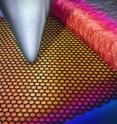Self-cooling observed in graphene elctronics
With the first observation of thermoelectric effects at graphene contacts, University of Illinois researchers found that graphene transistors have a nanoscale cooling effect that reduces their temperature. Led by mechanical science and engineering professor William King and electrical and computer engineering professor Eric Pop, the team will publish its findings in the April 3 advance online edition of the journal Nature Nanotechnology.
The speed and size of computer chips are limited by how much heat they dissipate. All electronics dissipate heat as a result of the electrons in the current colliding with the device material, a phenomenon called resistive heating. This heating outweighs other smaller thermoelectric effects that can locally cool a device. Computers with silicon chips use fans or flowing water to cool the transistors, a process that consumes much of the energy required to power a device.
Future computer chips made out of graphene – carbon sheets 1 atom thick – could be faster than silicon chips and operate at lower power. However, a thorough understanding of heat generation and distribution in graphene devices has eluded researchers because of the tiny dimensions involved.
The Illinois team used an atomic force microscope tip as a temperature probe to make the first nanometer-scale temperature measurements of a working graphene transistor. The measurements revealed surprising temperature phenomena at the points where the graphene transistor touches the metal connections. They found that thermoelectric cooling effects can be stronger at graphene contacts than resistive heating, actually lowering the temperature of the transistor.
"In silicon and most materials, the electronic heating is much larger than the self-cooling," King said. "However, we found that in these graphene transistors, there are regions where the thermoelectric cooling can be larger than the resistive heating, which allows these devices to cool themselves. This self-cooling has not previously been seen for graphene devices."
This self-cooling effect means that graphene-based electronics could require little or no cooling, begetting an even greater energy efficiency and increasing graphene's attractiveness as a silicon replacement.
"Graphene electronics are still in their infancy; however, our measurements and simulations project that thermoelectric effects will become enhanced as graphene transistor technology and contacts improve " said Pop, who is also affiliated with the Beckman Institute for Advanced Science, and the Micro and Nanotechnology Laboratory at the U. of I.
Next, the researchers plan to use the AFM temperature probe to study heating and cooling in carbon nanotubes and other nanomaterials.
Source: University of Illinois at Urbana-Champaign
Other sources
- Self-cooling observed in graphene elctronicsfrom Science BlogMon, 4 Apr 2011, 3:30:17 UTC
- Self-cooling observed in graphene elctronicsfrom Science DailyMon, 4 Apr 2011, 2:30:16 UTC
- Self-cooling observed in graphene elctronicsfrom PhysorgSun, 3 Apr 2011, 17:30:44 UTC
